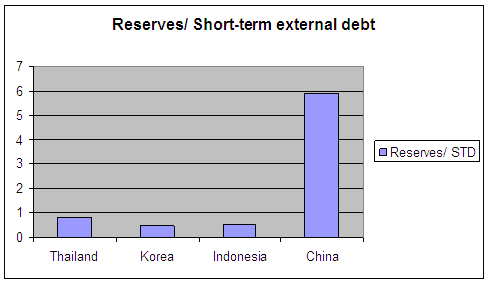In an attempt to be fair and balanced
More on:
Personally, I think the choice of variables dictated the study's results, and I don't particularly like the choice of variables. China has an unusually high broad money to GDP ratio, so its reserves to broad money ratio is not all that high, even though its reserves to GDP ratio is very high for a major continental-sized economy. And since China trades a lot for a continental economy, it imports are a lot for a large economy that too keep keeps China from being an outlier. The model basically assumes that since Chinese imports/ GDP is about two times those of a country like the US (for the record, Chinese exports/ GDP are about four times that of the US, 40% v 10%) it should have more reserves than the US. Since small city states like Singapore and Hong Kong trade a lot and have high levels of reserves, the source of the more trade/ more reserves correlation is not hard to find.
Consequently, by looking at imports/ GDP and M2 (broad money) to reserves, the author's happened to pick the variables most likely to show that China really is just accumulating reserves for precautionary reasons.
However, I am not convinced that trade flows are the best way of measuring reserve adequacy; I prefer short-term debt to reserves. For dollarized economies with open capital accounts, i would add in a measure that includes the potential outflow of domestic dollar deposits -- but this is not an issue for China, which has a closed capital account and very few domestic dollar deposits.
China's huge M2 to GDP ratio reflects financial underdevelopment (all savings in the financial system take the form of bank deposits, and thus count as money; securities markets are underdeveloped) reinforced by extensive capital controls. Yet those same capital controls reduce China's external vulnerabilities - Chinese depositors with RMB cannot convert their savings into dollars, or euros. So I am also not convinced M2/ reserves is the right measure for China -- it is low because both M2 to GDP and reserves to GDP are unusually high.
If you look at a variable that is left out of the Aizenmann and Lee study -- reserves to short-term debt, China clearly has far more reserves than it needs. Hell, China has far more reserves than it has external debt, let alone short-term external debt. Consider this graph, which shows China's reserves to short-term external debt at the end of 2004 v. the reserves to short-term debt of selected Asian economies at the end of 1996. A number below one is a sign of danger. But, setting aside heavily dollarized economies, I am not sure that you need more than 2 times as many reserves as short-term external debt (for wonks, on a residual maturity basis) either.

The World Bank put more emphasis on reserves to short-term debt in their assessment, and came to a rather different conclusion in their spring report on Global Development Finance. Indeed, the World Bank, to be honest, seems a bit ahead of the IMF on this issue. I should emphasize though that the output of a couple of economists in the research department does not reflect the collective judgment of the IMF. But I have not seen a clear statement from the IMF that China now has more reserves than it needs either.
Both China's overall reserves to GDP ratio (heading toward 50% at the end of the year) and the pace of its reserve accumulation (near 15% of GDP) are way high for a major economy. China makes Japan look massively under-reserved, since Japan's reserves are less than 20% fo its GDP. And it certainly makes the US look under-reserved. The US holds less than 1% of GDP as reserves (and getting close to 1% of GDP requires a pretty generous definition of reserves). I can accept that China needs ten times as many reserves as the US, even twenty times as many. But fifty or more?
More on:
 Online Store
Online Store
